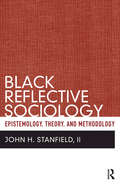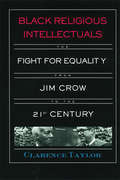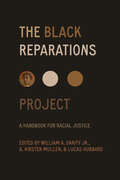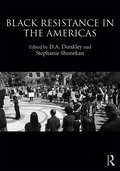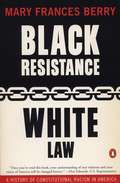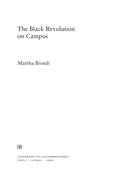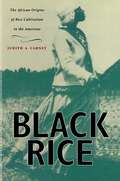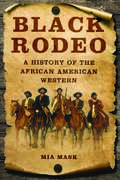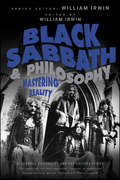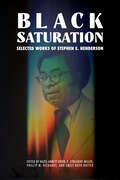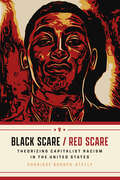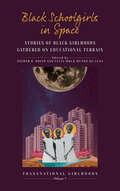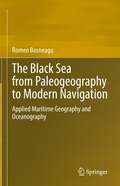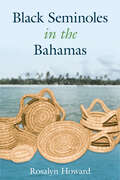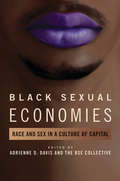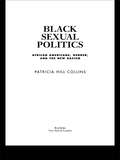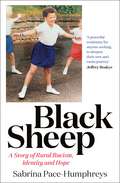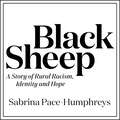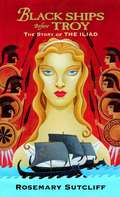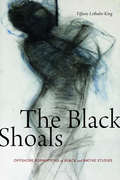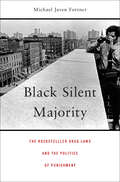- Table View
- List View
Black Reflective Sociology: Epistemology, Theory, and Methodology
by John H Stanfield IIJohn H. Stanfield II, the leading contemporary Black sociologist of knowledge, distills decades of his research and thinking in a set of articles—some original to the volume, others from fugitive sources—that address race in the formation of epistemologies, theories, and methodologies in social science. Stanfield’s contributions to the discipline, such as the adoption of restorative justice as an anti-racism solution in multiracial societies and the development of African diasporic sociological reasoning, are highlighted here. Ranging widely across theoretical, methodological, and substantive topics, Stanfield creates a reflective sociology viewed through an African diasporic lens that enriches the thinking and practice of social science.
Black Religious Intellectuals: The Fight for Equality from Jim Crow to the 21st Century (Crosscurrents in African American History)
by Clarence TaylorProfessor Clarence Taylor sheds some much-needed light on the rich intellectual and political tradition that lies in the black religious community. From the Pentecostalism of Bishop Smallwood Williams and the flamboyant leadership of the Reverend Al Sharpton, to the radical Presbyterianism of Milton Arthur Galamison and the controversial and mass-mobilization by Minister Louis Farrakhan, black religious leaders have figured prominently in the struggle for social equality in America.
The Black Reparations Project: A Handbook for Racial Justice
by William A. Darity Jr., A. Kirsten Mullen, and Lucas HubbardThis groundbreaking resource moves us from theory to action with a practical plan for reparations. A surge in interest in black reparations is taking place in America on a scale not seen since the Reconstruction Era. The Black Reparations Project gathers an accomplished interdisciplinary team of scholars—members of the Reparations Planning Committee—who have considered the issues pertinent to making reparations happen. This book will be an essential resource in the national conversation going forward. The first section of The Black Reparations Project crystallizes the rationale for reparations, cataloguing centuries of racial repression, discrimination, violence, mass incarceration, and the immense black-white wealth gap. Drawing on the contributors’ expertise in economics, history, law, public policy, public health, and education, the second section unfurls direct guidance for building and implementing a reparations program, including draft legislation that addresses how the program should be financed and how claimants can be identified and compensated. Rigorous and comprehensive, The Black Reparations Project will motivate, guide, and speed the final leg of the journey for justice.
The Black Reproductive: Unfree Labor and Insurgent Motherhood
by Sara Clarke KaplanHow Black women&’s reproduction became integral to white supremacy, capitalism, and heteropatriarchy—and remains key to their dismantling In the United States, slavery relied on the reproduction and other labors of unfree Black women. Nearly four centuries later, Black reproductivity remains a vital technology for the creation, negotiation, and transformation of sexualized and gendered racial categories. Yet even as Black reproduction has been deployed to resolve the conflicting demands of white supremacy, capitalism, and heteropatriarchy, Sara Clarke Kaplan argues that it also holds the potential to destabilize the oppressive systems it is supposed to maintain.The Black Reproductive convenes Black literary and cultural studies with feminist and queer theory to read twentieth- and twenty-first-century texts and images alongside their pre-emancipation counterparts. These provocative, unexpected couplings include how Toni Morrison&’s depiction of infanticide regenders Orlando Patterson&’s theory of social death, and how Mary Prince&’s eighteenth-century fugitive slave narrative is resignified through the representational paradoxes of Gayl Jones&’s blues novel Corregidora. Throughout, Kaplan offers new perspectives on Black motherhood and gendered labor, from debates over the relationship between President Thomas Jefferson and Sally Hemings, to the demise of racist icon Aunt Jemima, to discussions of Black reproductive freedom and abortion. The Black Reproductive gives vital insight into the historic and ongoing conditions of Black unfreedom, and points to the possibilities for a Black feminist practice of individual and collective freedom.
Black Resistance in the Americas
by D. A. Dunkley Stephanie ShonekanAll across the US in the last few years, there has been a resurgence of Black protest against structural racism and other forms of racial injustice. Black Resistance in the Americas draws attention to this renewed energy and how this theme of resistance intersects with other communities of Black people around the world. This edited collection examines in depth stories of resistance against slavery, narratives of resistance in African American, Afro-Caribbean, and Afro-Latin American Literature, resistance in politics, education, religion, music, dance, and film, exploring a range of new perspectives from established and emerging researchers on Black communities. The essays in this pivotal book discuss some of the mechanisms that Black communities have used to resist bondage, domination, disempowerment, inequality, and injustices resulting from their encounters with the West, from colonization to forced migration.
Black Resistance, White Law: A History of Constitutional Racism in America
by Mary Frances BerryHow the government has used the Constitution to deny black Americans their legal rights From the arrival of the first twenty slaves in Jamestown to the Howard Beach Incident of 1986, Yusef Hawkins, and Rodney King, federal law enforcement has pleaded lack of authority against white violence while endorsing surveillance of black rebels and using "constitutional" military force against them. In this groundbreaking study, constitutional scholar Mark Frances Berry analyzes the reasons why millions of African Americans whose lives have improved enormously, both socially and economically, are still at risk of police abuse and largely unprotected from bias crimes.
The Black Revolution on Campus
by Martha BiondiThe Black Revolution on Campus is the definitive account of an extraordinary but forgotten chapter of the black freedom struggle. In the late 1960s and early 1970s, Black students organized hundreds of protests that sparked a period of crackdown, negotiation, and reform that profoundly transformed college life. At stake was the very mission of higher education. Black students demanded that public universities serve their communities; that private universities rethink the mission of elite education; and that black colleges embrace self-determination and resist the threat of integration. Most crucially, black students demanded a role in the definition of scholarly knowledge. Martha Biondi masterfully combines impressive research with a wealth of interviews from participants to tell the story of how students turned the slogan "black power" into a social movement. Vividly demonstrating the critical linkage between the student movement and changes in university culture, Biondi illustrates how victories in establishing Black Studies ultimately produced important intellectual innovations that have had a lasting impact on academic research and university curricula over the past 40 years. This book makes a major contribution to the current debate on Ethnic Studies, access to higher education, and opportunity for all.
Black Rice: The African Origins of Rice Cultivation in the Americas
by Judith A. CarneyFew Americans identify slavery with the cultivation of rice, yet rice was a major plantation crop during the first three centuries of settlement in the Americas. Rice accompanied African slaves across the Middle Passage throughout the New World to Brazil, the Caribbean, and the southern United States. By the middle of the eighteenth century, rice plantations in South Carolina and the black slaves who worked them had created one of the most profitable economies in the world. Black Rice tells the story of the true provenance of rice in the Americas. It establishes, through agricultural and historical evidence, the vital significance of rice in West African society for a millennium before Europeans arrived and the slave trade began. The standard belief that Europeans introduced rice to West Africa and then brought the knowledge of its cultivation to the Americas is a fundamental fallacy, one which succeeds in effacing the origins of the crop and the role of Africans and African-American slaves in transferring the seed, the cultivation skills, and the cultural practices necessary for establishing it in the New World. In this vivid interpretation of rice and slaves in the Atlantic world, Judith Carney reveals how racism has shaped our historical memory and neglected this critical African contribution to the making of the Americas.
Black Rodeo: A History of the African American Western
by Mia MaskAfrican American westerns have a rich cinematic history and visual culture. Mia Mask examines the African American western hero within the larger context of film history by considering how Black westerns evolved and approached wide-ranging goals. Woody Strode’s 1950s transformation from football star to actor was the harbinger of hard-edged western heroes later played by Jim Brown and Fred Williamson. Sidney Poitier’s Buck and the Preacher provided a narrative helmed by a groundbreaking African American director and offered unconventionally rich roles for women. Mask moves from these discussions to consider blaxploitation westerns and an analysis of Jeff Kanew’s hard-to-find 1972 documentary about an all-Black rodeo. The book addresses how these movies set the stage for modern-day westploitation films like Django Unchained. A first-of-its kind survey, Black Rodeo illuminates the figure of the Black cowboy while examining the intersection of African American film history and the western.
Black Sabbath and Philosophy
by William IrwinA philosophical look at heavy metal's dark masters of reality, Black SabbathBlack Sabbath is one of the world's most influential and enduring rock bands. Dubbed "the Beatles of heavy metal" by Rolling Stone, they helped to define a genre with classic songs like "Paranoid", "Iron Man", and "War Pigs", songs whose lyrics reveal hidden depth and philosophical insight. Their songs confront existential despair, social instability, political corruption, the horrors of war, and the nature of evil. This book explores the wide range of profound ideas in the band's music and lyrics to help you understand Black Sabbath as never before.Discusses and debates essential Black Sabbath topics and themes, such as the problem of evil, "War Pigs" and the nature of just war theory, whether or not Sabbath is still Sabbath without Ozzy, and whether "evil is in the ear of the beholder"Gives you new perspectives on Black Sabbath's music and lyricsProvides a deeper appreciation and understanding of Ozzy Osbourne, Tony Iommi, Geezer Butler, Bill Ward, and Ronnie James DioBrings some of history's heaviest thinkers to bear on the band's music, from Aristotle and Nietzsche to Schopenhauer and MarxSo . . . can you help me, occupy my brain? Yes! Start reading Black Sabbath and Philosophy.
Black Saturation: Selected Works of Stephen E. Henderson (Margaret Walker Alexander Series in African American Studies)
by Hazel Arnett Ervin E. Ethelbert Miller Phillip M. Richards Emily Ruth RutterCommitted to developing frameworks for defining and evaluating Black poetry, literary scholar Stephen E. Henderson (1925–1997) examined the question: What makes a poem Black? In his critical approach, Henderson prioritized form but not at the expense of source, function, or context, and, in so doing, developed convincing theoretical frameworks for examining African American lyric expressions, especially that of Black Arts poets. Black Saturation: Selected Works of Stephen E. Henderson is designed to expand and enrich understandings of Henderson’s critical corpus by showcasing many of his most essential essays, presentations, and syllabi in a standalone volume. Henderson deftly conceptualized the ways in which aesthetic innovations were interwoven with revolutionary exigencies—a marriage of poetry and politics that became a hallmark of the 1960s and ’70s. While other critics often ignored or fumbled to construct an adequate rubric for evaluating and celebrating Black Arts poetry—penned by Amiri Baraka, Carolyn Rodgers, Sonia Sanchez, Jayne Cortez, Mari Evans, Sarah Webster Fabio, Haki Madhubuti, and Larry Neal, among many others—Henderson constellated a triad of interdependent characteristics (structure, theme, and saturation) through which he examined Black literature in general and poetry in particular. Revisiting Henderson’s scholarship in the third decade of the twenty-first century allows us, on the one hand, to further appreciate his imprint on current scholarship about Black literature, especially poetry, and, on the other, to introduce contemporary students and scholars to his salient theoretical frameworks, not to mention his persuasive critical style.
Black Scare / Red Scare: Theorizing Capitalist Racism in the United States
by Charisse Burden-StellyA radical explication of the ways anti-Black racial oppression has infused the US government’s anti-communist repression. In the early twentieth century, two panics emerged in the United States. The Black Scare was rooted in white Americans’ fear of Black Nationalism and dread at what social, economic, and political equality of Black people might entail. The Red Scare, sparked by communist uprisings abroad and subversion at home, established anticapitalism as a force capable of infiltrating and disrupting the American order. In Black Scare / Red Scare, Charisse Burden-Stelly meticulously outlines the conjoined nature of these state-sanctioned panics, revealing how they unfolded together as the United States pursued capitalist domination. Antiradical repression, she shows, is inseparable from anti-Black oppression, and vice versa. Beginning her account in 1917—the year of the Bolshevik Revolution, the East St. Louis Race Riot, and the Espionage Act—Burden-Stelly traces the long duration of these intertwined and mutually reinforcing phenomena. She theorizes two bases of the Black Scare / Red Scare: US Capitalist Racist Society, a racially hierarchical political economy built on exploitative labor relationships, and Wall Street Imperialism, the violent processes by which businesses and the US government structured domestic and foreign policies to consolidate capital and racial domination. In opposition, Radical Blackness embodied the government’s fear of both Black insurrection and Red instigation. The state’s actions and rhetoric therefore characterized Black anticapitalists as foreign, alien, and undesirable. This reactionary response led to an ideology that Burden-Stelly calls True Americanism, the belief that the best things about America were absolutely not Red and not Black, which were interchangeable threats. Black Scare / Red Scare illuminates the anticommunist nature of the US and its governance, but also shines a light on a misunderstood tradition of struggle for Black liberation. Burden-Stelly highlights the Black anticapitalist organizers working within and alongside the international communist movement and analyzes the ways the Black Scare/Red Scare reverberates through ongoing suppression of Black radical activism today. Drawing on a range of administrative, legal, and archival sources, Burden-Stelly incorporates emancipatory ideas from several disciplines to uncover novel insights into Black political minorities and their legacy.
Black Schoolgirls in Space: Stories of Black Girlhoods Gathered on Educational Terrain (Transnational Girlhoods #7)
by Esther O. Ohito and Lucía Mock Muñoz de LunaLocating Black girls’ desires, needs, knowledge bases, and lived experiences in relation to their social identities has become increasingly important in the study of transnational girlhoods. Black Schoolgirls in Space pushes this discourse even further by exploring how Black girls negotiate and navigate borders of blackness, gender, and girlhood in educational spaces. The contributors of this collected volume highlight Black girls as actors and agents of not only girlhood but also the larger, transnational educational worlds in which their girlhoods are contained.
The Black Sea and the Early Civilizations of Europe, the Near East and Asia
by Mariya IvanovaThe Black Sea lies at the junction of three major cultural areas: Europe, Central Asia, and the Near East. It plays a crucial role in enduring discussions about the impact of complex Near Eastern societies on European societies, and the repercussions of early urbanization across Eurasia. This book presents the first comprehensive overview of the Black Sea region in the prehistoric period. It penetrates artificial boundaries imposed by traditions, politics, and language to encompass both the European and Asiatic coasts and both Eastern European and Western scholarly literature. With a critical compilation and synthesis of archaeological data, this study situates the prehistoric Black Sea in a global historical context. By adopting the perspective of technology and innovation, it transcends a purely descriptive account of material culture and emphasizes society, human interaction, and engagement with the material world.
The Black Sea from Paleogeography to Modern Navigation: Applied Maritime Geography and Oceanography
by Romeo BosneaguThis book provides an analysis of the evolution of navigation and seaborne trade in the Black Sea, considering the geographic, geological, and hydro-meteorological data, including information from the historical, geopolitical, economic, social, and military frames. In ancient times the Black Sea was at the edge of the known world, and together with its coasts it preserves traces of the Greek, Roman, and Byzantine civilizations. Many of the ancient ports were important and essential towns, which remains the case in modern times. The complex geographical conditions that have historically influenced, and continue to influence the development of maritime trade and transport in the Black Sea, have not been thoroughly researched or optimized for these activities. The book is divided into ten chapters. Chapter I describes the physical – geographical conditions of the Black Sea’s basin, and the geological evolution of its recent history, with application to the hypothesis of Noah's flood. Chapter 2 presents a short history of the research conducted on the Black Sea upto present day. Chapter 3 summarizes the specific characteristics of the Black Sea’s morphohydrography and morphodynamics. Chapter 4 contains the conclusions regarding the influence of coastal relief on the navigation and seaborne trade on the Black Sea. Chapter 5 analyzes the Black Sea basin’s meteo-climatic regime. Chapter 6 contains the conclusions of the influence of weather and climate factors on the navigation and seaborne trade on the Black Sea. Chapter 7 describes the specific hydrological factors of the Black Sea. Chapter 8 contains the conclusions regarding the influence of the hydrological factors for the navigation and seaborne trade on the Black Sea. Chapter 9 presents the Black Sea’s specific hydrobiological elements specific, as a „unicum hydrobiologicum”, and the main features of the Black Sea’s ecology. Chapter 10 is concentrated on the historical, social, political, economic, and geopolitical framework of the Black Sea basin influencing navigation and maritime transportation, from ancient times to the present. The book is written from the perspective of a Romanian Navy officer, with more than 40 years’ experience in the Romanian Navy
Black Seminoles in the Bahamas
by Rosalyn Howard"An excellent case study of a little-studied and poorly known community experiencing the processes of identity formation and culture change."--Brent R. Weisman, University of South FloridaThis is the first full-length ethnography of a unique community within the African diaspora. Rosalyn Howard traces the history of the isolated "Red Bays" community of the Bahamas, from their escape from the plantations of the American South through their utilization of social memory in the construction of new identity and community.Some of the many African slaves escaping from southern plantations traveled to Florida and joined the Seminole Indians, intermarried, and came to call themselves Black Seminoles. In 1821, pursued and harassed by European Americans through the First Seminole War, approximately 200 members of this group fled to Andros Island, where they remained essentially isolated for nearly 150 years. Drawing on archival and secondary sources in the United States and the Bahamas as well as interviews with members of the present-day Black Seminole community on Andros Island, Howard reconstructs the story of the Red Bays people. She chronicles their struggles as they adapt to a new environment and forge a new identity in this insular community and analyzes the former slaves' relationship with their Native American companions.Black Seminoles in contemporary Red Bays number approximately 290, the majority of whom are descended directly from the original settlers. As part of her research, Howard lived for a year in this small community, recording its oral history and analyzing the ways in which that history informed the evolving identity of the people. Her treatment dispels the air of mystery surrounding the Black Seminoles of Andros and provides a foundation for further anthropological and historical investigations.
Black Sexual Economies: Race and Sex in a Culture of Capital (New Black Studies Series #111)
by Adrienne D. Davis the BSE CollectiveA daring collaboration among scholars, Black Sexual Economies challenges thinking that sees black sexualities as a threat to normative ideas about sexuality, the family, and the nation. The essays highlight alternative and deviant gender and sexual identities, performances, and communities, and spotlights the sexual labor, sexual economy, and sexual agency to black social life. Throughout, the writers reveal the lives, everyday negotiations, and cultural or aesthetic interventions of black gender and sexual minorities while analyzing the systems and beliefs that structure the possibilities that exist for all black sexualities. They also confront the mechanisms of domination and subordination attached to the political and socioeconomic forces, cultural productions, and academic work that interact with the energies at the nexus of sexuality and race.Contributors: Marlon M. Bailey, Lia T. Bascomb, Felice Blake, Darius Bost, Ariane Cruz, Adrienne D. Davis, Pierre Dominguez, David B. Green Jr., Jillian Hernandez, Cheryl D. Hicks, Xavier Livermon, Jeffrey McCune, Mireille Miller-Young, Angelique Nixon, Shana L. Redmond, Matt Richardson, L. H. Stallings, Anya M. Wallace, and Erica Lorraine Williams
Black Sexual Politics: African Americans, Gender, and the New Racism
by Patricia Hill CollinsIn Black Sexual Politics, one of America's most influential writers on race and gender explores how images of Black sexuality have been used to maintain the color line and how they threaten to spread a new brand of racism around the world today.
Black Sheep: A Story of Rural Racism, Identity and Hope
by Sabrina Pace-Humphreys'Honest and authentic - I could not put it down' Michelle Griffith Robinson OLY'Black Sheep is powerful testimony for anyone seeking to deepen their own anti-racist journey. This is passionate, raw writing, with moments of reflection that we can all learn from. It's a story that had to be told, and must be heard' Jeffrey BoakyeSabrina Pace-Humphreys is a 44-year-old mother of four and grandmother of three, an award-winning businesswoman, an ultrarunner, a social justice activist and a recovering alcoholic. She is a mixed-raced woman, the daughter of a white Scottish Roman Catholic woman and a Black man. When she was two, her parents separated and Sabrina, her mother and her white-presenting younger sister moved to a small market town where no-one looked like her. From as young as she can remember, she was the subject of verbal and physical racist abuse.In Black Sheep, Sabrina reveals how she got from there to here: about growing up in a home, a school and a town where no-one looked like her and her subsequent struggle to understand and find her identity; about her lived experience of rural racism; about becoming a teenage mother and her determination to break that stereotype; about her battle with alcoholism and her mental health; about how running saved her life; and ultimately about how someone can not only survive but thrive in spite of their past. Sabrina's experience will chime with anyone who has felt like an outsider. Poignant and eye-opening, and exploring themes of trauma, identity, mental health and addiction, Black Sheep is a tale of triumph: of grit and determination, of hope over despair.
Black Sheep: A Story of Rural Racism, Identity and Hope
by Sabrina Pace-Humphreys'Honest and authentic - I could not put it down' Michelle Griffith Robinson OLY'Black Sheep is powerful testimony for anyone seeking to deepen their own anti-racist journey. This is passionate, raw writing, with moments of reflection that we can all learn from. It's a story that had to be told, and must be heard' Jeffrey BoakyeSabrina Pace-Humphreys is a 44-year-old mother of four and grandmother of three, an award-winning businesswoman, an ultrarunner, a social justice activist and a recovering alcoholic. She is a mixed-raced woman, the daughter of a white Scottish Roman Catholic woman and a Black man. When she was two, her parents separated and Sabrina, her mother and her white-presenting younger sister moved to a small market town where no-one looked like her. From as young as she can remember, she was the subject of verbal and physical racist abuse.In Black Sheep, Sabrina reveals how she got from there to here: about growing up in a home, a school and a town where no-one looked like her and her subsequent struggle to understand and find her identity; about her lived experience of rural racism; about becoming a teenage mother and her determination to break that stereotype; about her battle with alcoholism and her mental health; about how running saved her life; and ultimately about how someone can not only survive but thrive in spite of their past. Sabrina's experience will chime with anyone who has felt like an outsider. Poignant and eye-opening, and exploring themes of trauma, identity, mental health and addiction, Black Sheep is a tale of triumph: of grit and determination, of hope over despair.
Black Sheep: A Story of Rural Racism, Identity and Hope
by Sabrina Pace-HumphreysSabrina Pace-Humphreys is a 43-year-old mother of four and grandmother of two, an award-winning businesswoman, an ultrarunner, a social justice activist and a recovering alcoholic. She is a mixed-raced woman, the daughter of a white Scottish Roman Catholic woman and a Black Church of England man. When she was two, her parents separated and Sabrina, her mother and her white-presenting younger sister moved to a small market town where no-one looked like her. From as young as she can remember, she was the subject of verbal and physical racist abuse.In Black Sheep, Sabrina reveals how she got from there to here: about growing up in a home, a school and a town where no-one looked like her and her subsequent struggle to understand and find her identity; about her lived experience of rural racism; about becoming a teenage mother and her determination to break that stereotype; about her battle with alcoholism and her mental health; about how running saved her life; and ultimately about how someone can not only survive but thrive in spite of their past. Sabrina's experience will chime with anyone who has felt like an outsider. Poignant and eye-opening, and exploring themes of trauma, identity, mental health and addiction, Black Sheep is a tale of triumph: of grit and determination, of hope over despair.(P) 2022 Quercus Editions Limited
Black Ships Before Troy: The Story of the Iliad
by Rosemary Sutcliff<P>The Story of the Iliad Homer's epic poem, The Iliad, is one of the greatest adventure stories of all time. In it, the abduction of the legendary beauty, Helen of Troy, leads to a conflict in which even the gods and goddesses take sides and intervene. <P>It is in the Trojan War that the most valiant heroes of the ancient world are pitted against one another. Here Hector, Ajax, Achilles, and Odysseus meet their most formidable challenges and in some cases their tragic ends. <P>[This text is listed as an example that meets Common Core Standards in English language arts in grades 6-8 at http://www.corestandards.org.]
The Black Shoals: Offshore Formations of Black and Native Studies
by Tiffany Lethabo KingIn The Black Shoals Tiffany Lethabo King uses the shoal—an offshore geologic formation that is neither land nor sea—as metaphor, mode of critique, and methodology to theorize the encounter between Black studies and Native studies. King conceptualizes the shoal as a space where Black and Native literary traditions, politics, theory, critique, and art meet in productive, shifting, and contentious ways. These interactions, which often foreground Black and Native discourses of conquest and critiques of humanism, offer alternative insights into understanding how slavery, anti-Blackness, and Indigenous genocide structure white supremacy. Among texts and topics, King examines eighteenth-century British mappings of humanness, Nativeness, and Blackness; Black feminist depictions of Black and Native erotics; Black fungibility as a critique of discourses of labor exploitation; and Black art that rewrites conceptions of the human. In outlining the convergences and disjunctions between Black and Native thought and aesthetics, King identifies the potential to create new epistemologies, lines of critical inquiry, and creative practices.
Black Silent Majority: The Rockefeller Drug Laws and the Politics of Punishment
by Michael Javen FortnerCurrent anti-drug policies are based on a set of controversial laws first adopted in New York in the early 1970s and championed by the state’s Republican governor, Nelson Rockefeller. Fortner traces how many blacks in New York came to believe that the rehabilitation-focused liberal policies of the 1960s had failed. Faced with economic malaise and rising rates of addiction and crime, they blamed addicts and pushers. By 1973, the outcry from grassroots activists and civic leaders in Harlem calling for drastic measures presented Rockefeller with a welcome opportunity to crack down on crime and boost his political career. New York became the first state to mandate long prison sentences for selling or possessing narcotics. Black Silent Majority lays bare the tangled roots of a pernicious system. America’s drug policies, while in part a manifestation of the conservative movement, are also a product of black America’s confrontation with crime and chaos in its own neighborhoods.
Black Silent Majority: The Rockefeller Drug Laws and the Politics of Punishment
by Michael Javen FortnerAggressive policing and draconian sentencing have disproportionately imprisoned millions of African Americans for drug-related offenses. Michael Javen Fortner shows that in the 1970s these punitive policies toward addicts and pushers enjoyed the support of many working-class and middle-class blacks, angry about the chaos in their own neighborhoods.
